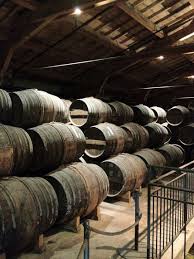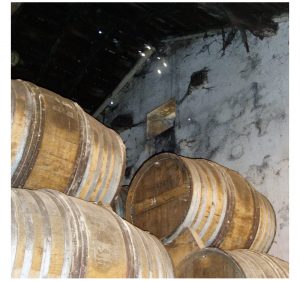Storage Temperature for Cognac
 ‘What is the safe storage temperature for cognac?’ is a question that comes up at regular intervals. It is worth noting that once cognac has been bottled, its maximum storage temperature becomes more critical. Usually, a suitable space is left between the cognac and the cork for expansion but every now and again we hear of shipments in very hot countries where the excessive heat has forced the corks out of the bottles. This is a rarity these days as modern corks are stronger and better than those made perhaps 25 years ago. Bottle sealing, especially for rare vintage cognacs, can also be enhanced with wax seals over the cork.
‘What is the safe storage temperature for cognac?’ is a question that comes up at regular intervals. It is worth noting that once cognac has been bottled, its maximum storage temperature becomes more critical. Usually, a suitable space is left between the cognac and the cork for expansion but every now and again we hear of shipments in very hot countries where the excessive heat has forced the corks out of the bottles. This is a rarity these days as modern corks are stronger and better than those made perhaps 25 years ago. Bottle sealing, especially for rare vintage cognacs, can also be enhanced with wax seals over the cork.
However, cognac temperatures, especially during the production and ageing periods can play an important role in the quality of what we drink years later. The distillation range of cognac is between 67 – 72.4 % abv yet most of that which is available in the shops is sold at 40% abv. The natural average drop in strength varies from 0.1% to 2% per year but it would be wrong to believe the average is between the two figures. The actual average is around 0.5% unless demineralised water has been added to the cognac during its storage life. Many of the commercial cognacs are stored for some of their short life in large wooden tanks with little more than a wood lid over them for protection. Here, the temperature, humidity or air dryness can have a considerable effect on both the cognac quality and speed of alcohol reduction. Cognacs that are stored in this manner are usually purchased by the big houses and used in VS or VSOP blends where additives are used to control their flavour and quality.
Of course, the controls over the bulk storage of cognac are very much down to the cellar master. Those cognacs which are destined for higher places will be stored in barrels and hidden away throughout their life in the cellars. The cognac which we store in our sideboard should ideally be kept at a temperature not greater than 25 degrees Celsius and above freezing. Providing the bottle remains sealed, the cognac will stay in perfect condition for decades. But, I hear you ask, what is the point of keeping a bottle without drinking it? Good point, but remember the more you drink from the bottle, the more air there will be in it and the more the alcohol will escape. Eventually the cognac becomes undrinkable. Don’t panic though, a 3/4 full bottle with the cork replaced after opening, may last in excess of 10 years. Even one only 1/4 full will still be drinkable a couple of years from now and who is going to leave a part full bottle of good cognac that long?

 The concept of barrel ageing is said to have been conceived by wine merchants when shipping their wines from the harbour at La Rochelle. The weak and commonly sweet wines that were shipped along the Charente from Cognac often became rancid. The wine merchants therefore reduced their volume by distillation, before shipping abroad in oak barrels. After their arrival in foreign ports it was noticed that the clear distillates within had coloured and gained in flavour.
The concept of barrel ageing is said to have been conceived by wine merchants when shipping their wines from the harbour at La Rochelle. The weak and commonly sweet wines that were shipped along the Charente from Cognac often became rancid. The wine merchants therefore reduced their volume by distillation, before shipping abroad in oak barrels. After their arrival in foreign ports it was noticed that the clear distillates within had coloured and gained in flavour.